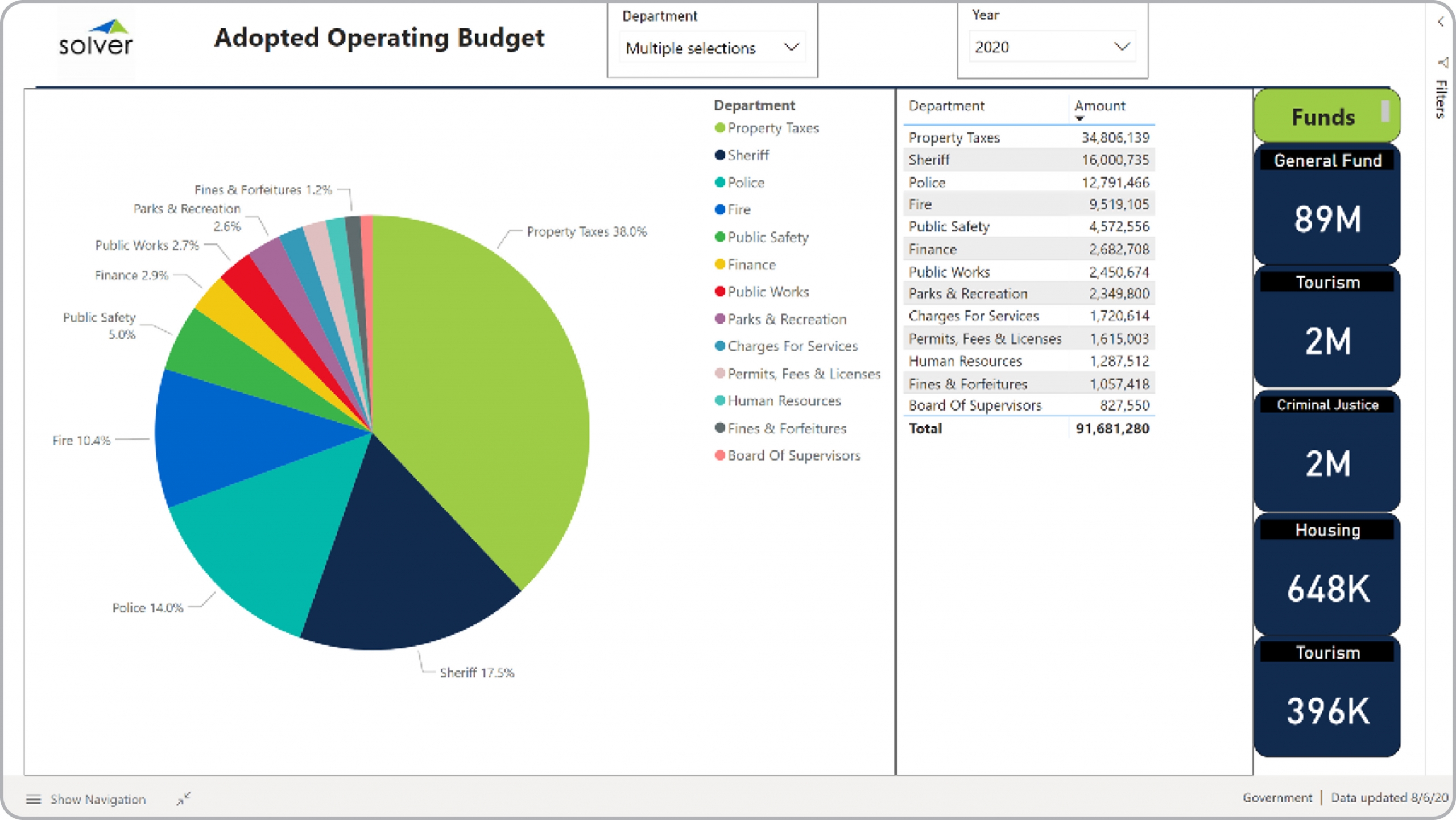Operating Budget Dashboard for Public Sector
What is an
Operating Budget Dashboard for Public Sector
? Operating Budget Dashboards are considered budget analysis tools and are used by executives and budget managers to review the adopted budget. Some of the main functionality in this type of dashboard is that it gives the users a single view of the budget with a mix of figures, KPIs and graphics, including: 1) Pie chart with comparison of opex account categories, 2) Ranked list of annual budgeted expenses, and 3) Summary metrics by fund. The dashboard can be filtered by year, department and fund. You find an example of this type of dashboard below.
Purpose of
Operating Budget Dashboards Government organizations use Operating Budget Dashboards to give finance teams and executives and clear and easy way to analyze the adopted annual budget. When used as part of good business practices in Financial Planning & Analysis (FP&A) departments, an organization can improve its budget accuracy, and it can reduce the chances that key decisionmakers lack good budgetary insight.
Example of a
Operating Budget Dashboard Here is an example of a Operating Budget Dashboard with summaries and analysis of expense categories. [caption id="" align="alignnone" width="2560"]
 Example of an Operating Budget Dashboard for Public Sector[/caption] You can find hundreds of additional examples
here
Who Uses This Type of
Dashboard
? The typical users of this type of dashboard are: Executives, boards, directors, budget officers, CFOs, analysts.
Other Reports Often Used in Conjunction with
Operating Budget Dashboards Progressive Financial Planning & Analysis (FP&A) departments sometimes use several different Operating Budget Dashboards, along with financial statements, annual budget reports, budget summary dashboards, detailed budget reports, budget input models and other management and control tools.
Where Does the Data for Analysis Originate From? The Actual (historical transactions) data typically comes from enterprise resource planning (ERP) systems like: Microsoft Dynamics 365 (D365) Finance, Microsoft Dynamics 365 Business Central (D365 BC), Microsoft Dynamics AX, Microsoft Dynamics NAV, Microsoft Dynamics GP, Microsoft Dynamics SL, Sage Intacct, Sage 100, Sage 300, Sage 500, Sage X3, SAP Business One, SAP ByDesign, Acumatica, Netsuite and others. In analyses where budgets or forecasts are used, the planning data most often originates from in-house Excel spreadsheet models or from professional corporate performance management (CPM/EPM) solutions.
What Tools are Typically used for Reporting, Planning and Dashboards? Examples of business software used with the data and ERPs mentioned above are:
Example of an Operating Budget Dashboard for Public Sector[/caption] You can find hundreds of additional examples
here
Who Uses This Type of
Dashboard
? The typical users of this type of dashboard are: Executives, boards, directors, budget officers, CFOs, analysts.
Other Reports Often Used in Conjunction with
Operating Budget Dashboards Progressive Financial Planning & Analysis (FP&A) departments sometimes use several different Operating Budget Dashboards, along with financial statements, annual budget reports, budget summary dashboards, detailed budget reports, budget input models and other management and control tools.
Where Does the Data for Analysis Originate From? The Actual (historical transactions) data typically comes from enterprise resource planning (ERP) systems like: Microsoft Dynamics 365 (D365) Finance, Microsoft Dynamics 365 Business Central (D365 BC), Microsoft Dynamics AX, Microsoft Dynamics NAV, Microsoft Dynamics GP, Microsoft Dynamics SL, Sage Intacct, Sage 100, Sage 300, Sage 500, Sage X3, SAP Business One, SAP ByDesign, Acumatica, Netsuite and others. In analyses where budgets or forecasts are used, the planning data most often originates from in-house Excel spreadsheet models or from professional corporate performance management (CPM/EPM) solutions.
What Tools are Typically used for Reporting, Planning and Dashboards? Examples of business software used with the data and ERPs mentioned above are:
- Native ERP report writers and query tools
- Spreadsheets (for example Microsoft Excel)
- Corporate Performance Management (CPM) tools (for example Solver)
- Dashboards (for example Microsoft Power BI and Tableau)
Corporate Performance Management (CPM) Cloud Solutions and More Examples
May 2, 2021
TAGS:
Reporting,
Solver,
report writer,
Microsoft,
approved,
template,
practice,
Acumatica,
visualization,
Netsuite,
Finance,
planning,
GP,
dashboard,
Government,
Business Central,
state,
excel,
ax,
budget dashboard,
forecast,
Budget,
Dynamics 365,
budgeting,
government dashboard,
Cloud,
Software,
adopted,
Tableau,
SAP,
example,
best,
Sage,
BC,
D365,
fund,
NAV,
Intacct,
public sector,
county,
city,
department,
operating budget,
CPM,
report,
SL,
Management,
dynamics,
Power BI

